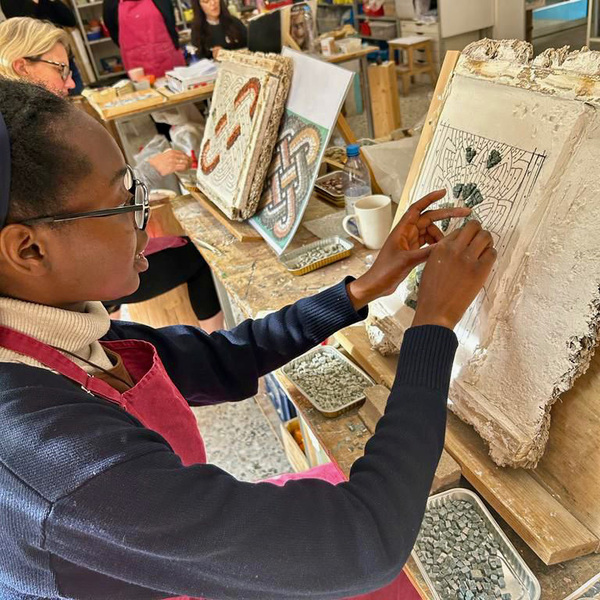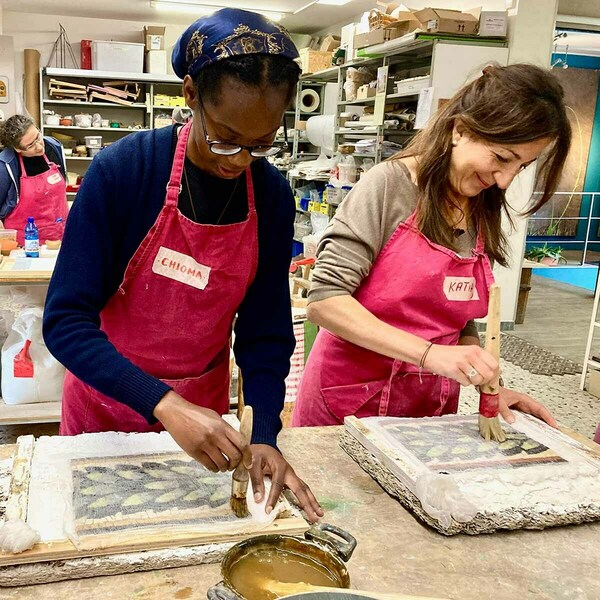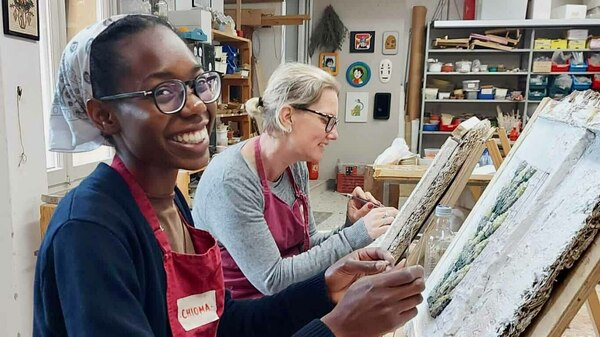
After spending the academic year 2022-23 studying in Rome, Chioma Oparaji ’25, a student at the University of Notre Dame’s School of Architecture, secured funding from the Nanovic Institute for European Studies to conduct research in the northern Italian city of Ravenna. In the course of her one week of research, Oparaji studied ancient Byzantine mosaics, participated in a five-day mosaic workshop, and visited Ravenna’s early Christian monuments.
Hiding behind the unassuming brick walls of Ravenna’s early Christian basilicas, ever-resplendent walls of mosaics stand announcing God’s glory and honoring His celestial family. Composed of thousands of minuscule stone or glass pieces called tesserae, each mosaic is the handwork of an artisan, wielding the simplest tools to adorn the most sacred spaces. By assigning each mosaic to a particular location, these artisans officiated the marriage of the ancient mosaics and their surrounding architecture. My research on location in Ravena, a northwestern Italian city that dates to at least the 5th century BC, aimed to understand this relationship in practice and reason through learning mosaic techniques and analyzing the architectural design principles of Ravenna’s basilicas.
... each mosaic is the handwork of an artisan, wielding the simplest tools to adorn the most sacred spaces. By assigning each mosaic to a particular location, these artisans officiated the marriage of the ancient mosaics and their surrounding architecture.
My freshman-year study of iconoclasm, which the historian Stanley J. Idzerda has described as the “premeditated destruction of visual symbols because of their specific emotional or ideological content,” sparked my interest in early Christian icons, or religious images. The negative effects of the Iconoclast Controversy, the 8th-9th century AD debate over the use of icons, led to the destruction of the mosaics in Constantinople, the capital of the Byzantine Empire and home to the most impressive forms of Byzantine mosaic artwork. But because of its proximity to the Western Roman Empire, where icons were revered, Ravenna stands as an exemplary site to study the earliest forms of mosaics and Catholic symbolism today.1
Thanks to the gracious support of a Nanovic Institute Summer Research Grant, I laid out my one-week research goal, which comprised completing a five-day mosaic technique course and conducting on-site analysis of three of Ravenna’s most notable 6th-century basilicas: San Apollinare Nuovo, San Vitale, and San Apollinare in Classe.
Learning centuries-old techniques hands-on at Koko Mosaico
As the Ravenna trip grew nearer, I became an iconophile, reading mosaic guidebooks and studying the plans, sections, and elevations of the basilicas for my case study. Despite this preparation, Ravenna’s climate had other plans for me. An unprecedented rainstorm caused a nearby river to flood, which forced the temporary closure of Ravenna’s school, monuments, and my beloved basilicas. So, instead of spending my time within the ancient wall of the basilicas, I studied primarily inside the walls of the mosaic workshop, my safe harbor during the storm.
Led by Ariana, a gregarious Italian mosaic artist and the co-founder of the Koko Mosaico studio, I learned two ancient methods of composing mosaics: the double-reverse technique and the direct technique on concrete. Beginning with some basics, I learned that each color tesserae corresponds to a different natural marble or glass (smalti) material, with varying ranges of hardnesses. Getting acquainted with the tools of Byzantine mosaicists, a .75-kilogram hammer and hardy, or pointed-anvil, became my newest companions to help me cut tesserae into squares, triangles, and trapezoids about the size of my thumbnail. While struggling to cut apart Verde Alpi, a dark-green marble, or to snap sugar-cube-textured blocks of white Carrara marble in half, I thought of the basilica walled with depictions of vast green meadows or deep blue skies, and the hours of intricate, difficult labor involved in cutting all the tesserae, before even beginning on the artistry of assembling the mosaics.
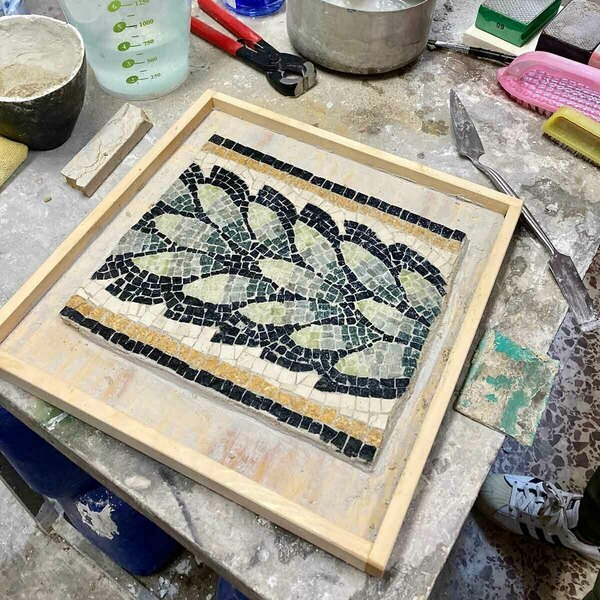
For my first mosaic, I began with the double-reverse technique, known as the “Ravenna technique.” This method begins by applying two layers of lime mortar onto a temporary wooden frame. Working with marble, I composed a floral detail from a Roman floor mosaic, similar to the colorful frame surrounding the haloed Mystic Lamb mosaic at San Vitale.
Though the preparation and finishing steps were numerous and time-consuming, the Ravenna technique’s saving grace is its work-time flexibility. Since lime mortar does not dry out quickly, I was able to work on the same surface for three days.
I took breaks whenever I needed and simply made sure that, at the end of each day, I covered my work with plastic after spraying it with a thin layer of water.
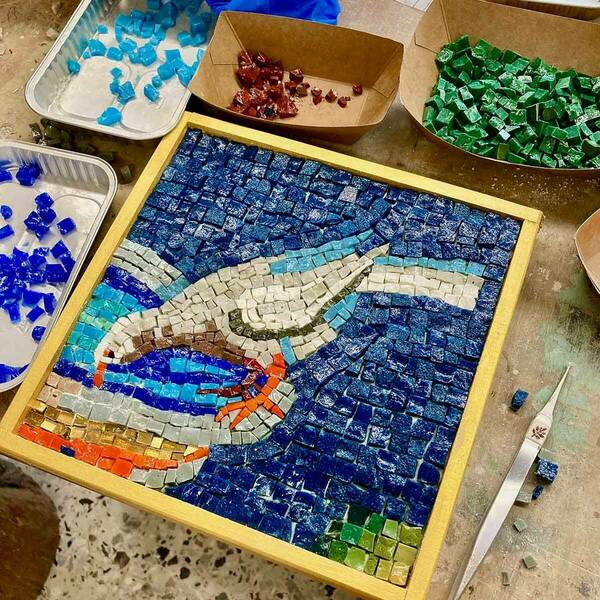
My relaxed work pace while using the Ravenna technique was soon replaced by the rapid-fire pace of the direct technique required for working on concrete. Using smalti and 24K gold leaf tesserae, I completed a detail of the Drinking Doves mosaic from the Mausoleum of Galla Placidia, which contains the oldest preserved mosaics in Ravenna.
Placing concrete directly on the finished frame, I worked in small sections because the surface remained workable for only about three hours before hardening.
Frankly, wet concrete is a possessive friend. Each sitting was devoted to completing a section with painstaking attention and no breaks. Yet, I appreciated the efficiency that this method demanded of me and the quick turn-around time to finish the mosaic.
Spaces that invite participation–and the hands that build them
... people come to a church to take part, not to view.
During my rained-in days, I continued to dream of the basilicas I had studied in my guidebooks. Yet, I learned the most from Margaret Visser’s book, The Geometry of Love: Space, Time, Mystery, and Meaning in an Ordinary Church (Perennial, 2001). In Visser’s analysis of Sant'agnese Fuori le Mura, an early Christian basilica in Rome, she notes that people come to a church to take part, not to view. Essentially, she argues that the mosaics served to aid the faithful in their faith journey and were best understood with attention to the architects’ and artisans’ original intentions, which were focused on the Christian ceremonies.
Luckily, before I left Ravenna, the rain subsided, and the basilicas reopened. With Visser’s work in mind, I set out to interact with the basilica’s architecture, not as an eager student, but as a devout faithful preparing to assist at the sacred liturgies.
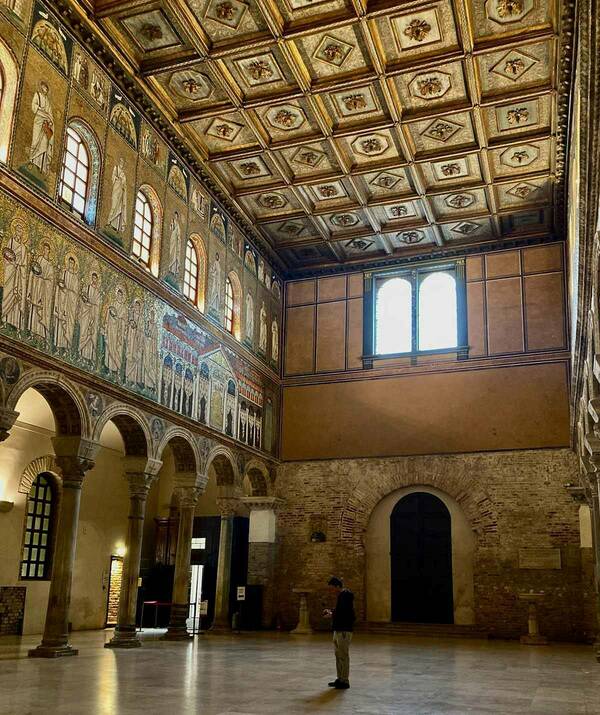
I sprinted to San Vitale and San Apollinare Nuovo before catching my departing train to Rome where I would be flying back to the United States. Standing in the nave, or central gathering space, I took note of the light sources and where I would have to be to see certain mosaics. For example, at San Apollinare Nuovo, the gold tesserae softly gleamed under the light from two large upper windows, and I imagined how candlelights might have illuminated the space in the past during an evening mass or divine liturgy.
Additionally, as a central-plan basilica in an octagonal shape, San Vitale’s mosaics should be viewed from the church’s original, but now inaccessible, entrance vestibule, rather than from the side entrance where tickets are checked today. From this perspective, one directly sees the apse, or semicircular central back wall, and is greeted by a mosaic of Christ the Redeemer offering a glorious crown to Saint Vitalis, an early martyr. I found it striking that, from my position at the original entrance, the famous mosaics of Emperor Justinian and Empress Theodora flanking the apse could barely be seen. Yet, a simple circumambulation of the basilica brought these mosaics into better view.
Their placement, it seems, intentionally invites one to make a procession around the church and gently draws them closer to the altar.
By completing the workshop, I better understood the integral role that mosaic artisans had in the completion of a basilica, as their mosaics transformed a bare assembly hall into an ornate space for worship. Today, the early Christian basilicas still serve as precedents for architects who wish to design spaces that follow a narrative and integrate artwork, especially handcrafted art forms, in ways that enhance the audience’s participation within a site, whether sacred or secular.
On leaving Ravenna with two mosaics in hand, I was confident that the icons helped the basilica preach the narratives of Faith and Catholic tradition from its walls. Now, when I look back at my snapshots of the mosaics in the basilicas, I not only see the glorious faces of Christ, Mary, and the saints but also the humble faces of the mosaicists, cutting apart tesserae for the greater glory of God.
Read about other students' experiences on Nanovic Navigator

1 For more on Byzantine religious icons see Osbert Lancaster, Sailing to Byzantium: An Architectural Companion (London: John Murray, 1969).
Originally published by at nanovicnavigator.nd.edu on August 09, 2023.
